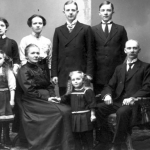Are you passionate about uncovering your family history but find yourself overwhelmed by piles of documents, photographs, and digital files? You’re not alone! As genealogists, we often collect vast amounts of information that can easily become disorganized and difficult to navigate. Knowing how to organize your genealogy r esearch is key to maintaining a productive and enjoyable research experience.
In this comprehensive guide, we’ll explore various techniques and tools to help you efficiently organize your genealogy research materials. From establishing a central filing system to leveraging genealogy software and online platforms, we’ll provide actionable tips for keeping your family history research in order, allowing you to focus on the fascinating stories that lie within your ancestry. Let’s dive in and discover how to create a well-organized system that preserves your valuable family history for future generations to come.
Why is Organization Crucial for Genealogy Research?
When you embark on the exciting journey of genealogy research, it’s essential to recognize the importance of organization. A well-organized system not only makes the research process more manageable, but it also comes with numerous other benefits. Let’s delve into the reasons why organization is crucial for genealogy research.
Enhances productivity and research efficiency: By having a structured system in place, you can easily locate the information you need, saving time and effort. This enables you to make faster progress and dig deeper into your family’s past.
Reduces duplication of work: Without proper organization, you may accidentally retrace your steps or reacquire the same documents. This can lead to wasted time and resources. A well-organized system allows you to see what information you already have and identify any gaps in your research.
Simplifies data sharing with family and fellow researchers: Organizing your genealogy research materials makes it easier to share your findings with others who are interested in your family history. This can help you collaborate and connect with distant relatives or fellow researchers who may possess valuable information or insights.
Preserves valuable information for future generations: Organized research materials are more likely to stand the test of time. By creating a well-structured system, you’re ensuring that your hard work and discoveries can be enjoyed by your descendants, providing them with a tangible link to their heritage.
As you can see, having a solid organization system is fundamental to the success of your genealogy research. In the following sections, we’ll explore various methods and tools for organizing your research materials effectively.
Establishing a Central Filing System
One of the first steps in organizing your genealogy research materials is to create a central filing system. This system will serve as the foundation for all your research and help you maintain order as you accumulate more information. In this section, we’ll discuss the different types of filing systems and offer tips for organizing, labeling, and indexing your materials.
Physical vs. Digital Filing Systems:
When choosing a filing system, you’ll need to decide whether to go with a physical or digital approach, or perhaps even a combination of both (a hybrid system). Physical filing systems, such as binders, folders, and filing cabinets, provide a tangible way to store and organize documents. They can be useful for preserving original records and photographs. However, they may take up considerable space and can be vulnerable to damage or loss.
On the other hand, digital filing systems offer a more compact and easily accessible option. By scanning and digitizing your documents, you can store vast amounts of information on your computer or in the cloud, making it easier to search, share, and backup your research. However, relying solely on digital files can also present risks, such as data loss or corruption. That’s why many researchers opt for a hybrid system that combines the benefits of both physical and digital storage.
Organizing Your Central Filing System:
Once you’ve chosen the type of filing system you want to use, the next step is to decide on an organization method. There are several approaches you can take, such as categorizing by family surname, filing by family group records, or filing by record type (e.g., birth certificates, marriage licenses, etc.). Whichever method you choose, consistency is key to maintaining an efficient filing system.
Labeling and Indexing:
Proper labeling and indexing are essential for quickly locating information within your filing system. Develop a consistent labeling technique, such as including the surname, first name, and document type, as well as any relevant dates. You may also want to consider color-coding your files to visually differentiate between different branches of your family tree. Finally, create an index or master list of all your files and their locations, making it easy to find specific materials when needed.
By establishing a central filing system that caters to your unique research needs, you’ll be well on your way to a more organized and efficient genealogy research experience.
Digitizing Your Research Materials
As the world becomes increasingly digital, genealogists are turning to digital tools to help them store, organize, and protect their research materials. In this section, we’ll cover the process of digitizing your documents and photographs, organizing digital files, and utilizing cloud storage and backup solutions.
Scanning Documents and Photographs:
To digitize your research materials, you’ll need to scan physical documents and photographs. When scanning, adhere to best practices such as using a high-quality scanner and choosing the appropriate file format (usually JPEG or TIFF for images, and PDF for documents) and resolution (300 dpi or higher). By doing so, you’ll ensure that your digital copies are clear, detailed, and suitable for long-term storage.
Organizing Digital Files:
Once you’ve digitized your materials, it’s essential to create a logical and consistent organization system for your digital files. Start by adopting a file naming convention that includes key details such as surname, first name, document type, and date. Then, create a folder structure that mirrors your central filing system, whether that’s organized by surname, family group, or record type. Maintaining a consistent digital organization system will make it easier to locate and manage your files.
Cloud Storage and Backup:
One of the main advantages of digitizing your genealogy research materials is the ability to store them in the cloud. Cloud storage not only provides easy access to your files from any device with an internet connection, but it also offers an additional layer of protection against data loss due to hardware failure or natural disasters. There are many cloud storage options available, such as Google Drive, Dropbox, or OneDrive, so choose one that suits your needs and budget. In addition to using cloud storage, it’s essential to perform regular backups of your digital files to ensure their safety and preservation.
By digitizing your genealogy research materials, you can streamline your organization process, safeguard your valuable information, and make it easier to collaborate and share your findings with others.
Leveraging Genealogy Software and Online Platforms
In today’s digital age, there is a wide variety of genealogy software programs and online platforms available to help you organize, analyze, and share your research materials. These tools can greatly enhance your family history research experience and keep your materials in order. In this section, we’ll discuss popular genealogy software options, online platforms, and mobile apps for on-the-go organization.
Genealogy Software Options:
Genealogy software programs can help you build, store, and manage your family tree, as well as organize your research materials. Some popular options include Ancestry.com’s Family Tree Maker, Gramps, RootsMagic, and Legacy Family Tree. These programs vary in terms of features, user interface, and pricing, so it’s crucial to compare them and choose the one that best fits your needs and preferences.
Online Platforms and Tools:
In addition to genealogy software, there are several online platforms and tools designed to help you organize and share your research. Websites such as Ancestry.com, FamilySearch.org, MyHeritage, and Findmypast offer a wealth of resources, including access to historical records, collaborative family trees, and forums where you can connect with other researchers. These platforms also frequently provide tools to help you organize and manage your research materials, making it even easier to keep track of your family history discoveries.
Mobile Apps for On-the-Go Organization:
For those who like to conduct research while away from their computer, numerous mobile apps can help you stay organized on-the-go. Top genealogy apps like Ancestry, FamilySearch Tree, and MyHeritage allow you to access your family tree and research materials from your smartphone or tablet. Many of these apps also sync with your desktop software and cloud storage, ensuring that your research is always up-to-date and accessible, no matter where you are.
By incorporating genealogy software, online platforms, and mobile apps into your research toolkit, you’ll be better equipped to manage and organize your genealogy research materials, collaborate with others, and uncover new details about your family’s past.
Organizing Physical Materials and Artefacts
While digitization offers many benefits, it’s also important to properly organize and store your physical genealogy materials and artefacts. These items not only provide a tangible connection to your family’s past, but they can also be valuable sources of information that you’ll want to preserve for future generations. In this section, we’ll discuss storage options, cataloging physical items, and storing and displaying family heirlooms.
Storage Options:
When it comes to storing physical materials such as documents, photographs, and heirlooms, it’s essential to use archival-quality storage materials. Acid-free folders, envelopes, and storage boxes can help protect your items from deterioration over time. Also, consider the environmental conditions of your storage area, aiming for a stable temperature and humidity level to minimize damage to your materials.
Cataloging Physical Items:
To keep track of your physical materials and artefacts, create an inventory that includes descriptions, dates, and any relevant historical context. Additionally, label each item with a unique identifier and cross-reference it with your digital files to easily locate corresponding information. This catalog will serve as a valuable resource for future generations interested in your family history.
Storing and Displaying Family Heirlooms:
Family heirlooms often hold significant sentimental value and can bring your family’s history to life. To preserve these cherished items, follow proper preservation techniques such as storing them in acid-free containers and avoiding exposure to direct sunlight or extreme temperatures. When it comes to displaying your family heirlooms, look for creative ways to showcase your family history while protecting the items from potential damage. Shadow boxes, display cases, and custom framing are just a few options to consider.
By giving your physical genealogy materials and artefacts the care and attention they deserve, you’ll not only be preserving your family’s history but also creating a lasting legacy for future generations to explore and appreciate.
Maintaining Your Organization System
Once you’ve established an effective organization system for your genealogy research materials, it’s essential to maintain and update it regularly. A well-maintained system will continue to serve you well as you uncover more information and make new discoveries. In this final section, we’ll discuss strategies for keeping your organization system up-to-date, including regular audits, continuous learning and adapting, and involving family members in the process.
Regular Updates and Audits:
Set aside time periodically to review and update your genealogy organization system. This may involve adding new information, reorganizing existing materials, or refining your system to better suit your needs. Conducting regular audits will help you identify areas for improvement and ensure that your system remains efficient and easy to navigate.
Continuously Learning and Adapting:
As with any field, genealogy research is constantly evolving, and new tools and techniques are regularly being developed. Stay current with the latest trends and best practices by participating in online forums, attending workshops or webinars, and joining local genealogy groups. By staying informed and adapting your organization system as needed, you’ll continue to optimize your research process.
Involving Family Members:
One of the most rewarding aspects of genealogy research is sharing your discoveries with your family. Encourage your family members to participate in the research process and contribute their own findings. By involving others in your family history journey, you’ll not only strengthen your organization system but also create a shared sense of ownership and pride in your family’s past.
In conclusion, a well-organized genealogy research system is the foundation of a successful family history journey. By following the strategies and techniques outlined in this guide, you’ll be well-equipped to manage your research materials, uncover new insights, and preserve your family’s legacy for generations to come. So, embrace the process, explore different methods, and find the approach that works best for your unique research journey. Happy researching!
Image Source:
- Filingtheoldfashionedway: Library of Congress





